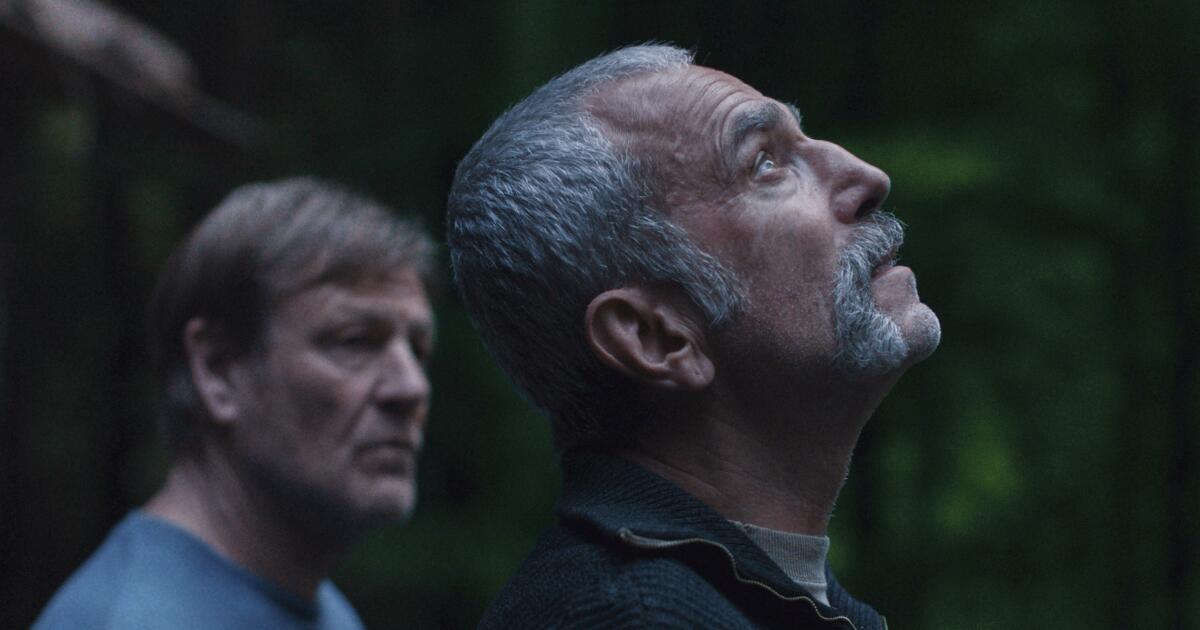When we first encounter Daniel Day-Lewis in “Anemone,” we only see him from the back, but there’s no mistaking him. Chopping wood outside his character’s rustic cabin in the middle of nowhere, he drives the ax down again and again, ferociously focused on the task at hand. At his best, which was often, Day-Lewis pursued acting with a primal clarity. Fittingly, his return to the big screen after announcing a retirement in 2017 is in a movie that exudes the same stark, elemental quality. He didn’t just co-write this tale of two estranged brothers excavating their complicated history — he imbues it with his essence, its reason for being.
“Anemone” isn’t just a film about family but one made by a father and his son. It’s the feature directorial debut of Ronan Day-Lewis, who collaborated with his Oscar-winning dad on the screenplay. Ronan, better known as a painter in New York’s contemporary art world, chronicles a collection of still lives who jostle themselves out of an emotional stupor.
Set in England some time during the mid-1990s, the movie opens as Jem (Sean Bean) says goodbye to his melancholy partner Nessa (Samantha Morton) and troubled son Brian (Samuel Bottomley) to venture out into the forest to reconnect with his younger brother Ray (Daniel Day-Lewis), whom he hasn’t spoken to in 20 years. A deeply religious man — he has “Only God Can Judge Me” sternly tattooed across his back — Jem is on a mission whose purpose will only slowly be revealed. When he arrives at Ray’s cabin, Ray knows it’s him before he even sets eyes on his brother. For several agonizing minutes, they sit together saying nothing, as Black Sabbath’s mystical ballad “Solitude” plays softly on the stereo. The tense silence will be the first of several battles of will between the two men, neither willing to yield.
Day-Lewis, now 68 and whose last film was Paul Thomas Anderson’s “Phantom Thread,” seems carved out of stone as Ray, his close-cropped hair and imposing gray goatee suggesting a man who doesn’t just live off the grid but thrives there. Lean and athletic, with a wildness in his eyes, Ray displays the same antagonism as Day-Lewis’ Bill the Butcher from “Gangs of New York” or Daniel Plainview in “There Will Be Blood.” Ray’s mysterious and fraught history as a member of the British military during the Troubles is a festering boil this film will eventually lance. His brother, who also served in the military, has come to speak to Ray about something more personal, but the hells they experienced in that conflict are the larger issue they must confront.
Shot by cinematographer Ben Fordesman in the Welsh countryside, “Anemone” takes place largely in a sprawling woods, Ronan Day-Lewis lending the flinty drama a mythic grandeur. Bobby Krlic’s mournful score is alternately dreamy and eerie, the instrumental music abruptly cutting out in the middle of a hypnotic passage. Wordless interludes find Jem and Ray dancing to music or sparring as boxers, their simmering feud reduced to its core elements of rugged masculinity and sibling rivalry. The artist-turned-filmmaker even incorporates a striking image from one of his oils — that of a translucent horselike creature — as an enigmatic visual motif that proves more ponderous than poetic.
This is not the first time Daniel Day-Lewis has worked closely with family. Twenty years ago, he starred in his wife Rebecca Miller’s father-daughter fable “The Ballad of Jack and Rose.” Both that film and “Anemone” concern solitary men who opted out of society, only to discover that such a plan is difficult to sustain. But they also both suffer from what might be described as an excess of dramatic seriousness, which is especially true of “Anemone.” Whether it’s Morton’s perpetually scowling expression in the infrequent cutaways to Brian’s life back home or the on-the-nose emphasis on looming gray clouds, there’s no question a storm is coming. Even “Anemone’s” rare moments of levity feel drained of color, the weight of this family’s Dark Past so severe that not an ounce of light (or lightness) can be permitted to escape.
Not surprisingly, the star almost makes the movie’s suffocating gloom resonate. “Anemone” allows Day-Lewis to be volcanic when Ray launches into a disturbing, ultimately revolting monologue about a recent run-in with a pedophiliac priest from childhood. Later, when the film finally explains why Ray abandoned the world, Day-Lewis delivers a teary confession that doesn’t have much fresh to say about the insanity of war but is nonetheless ennobled by how he unburdens his stoic character through cascading waves of anger and shame.
Even when he’s been fiery, nearly frothing at the mouth, Day-Lewis has always been a master of stillness, relying on his tall, taut frame to hint at the formidable power or menace underneath. (When his characters explode, it’s shocking, and yet we somehow knew the blast was imminent.) For Ray, a man full of rage who has no patience for religion, sentimentality or forgiveness, his brother’s arrival is an unwelcome event, and even when a slight thawing occurs between them, Day-Lewis remains coiled, ready to strike, their fragile truce constantly in danger of being upended.
But because Jem, like so many of these characters, is underwritten, Bean has to fall back on generalized manly intensity, which turns their showdowns into actorly exercises. The interactions are bracing but also a bit studied — the performers’ technique is more impressive than the story, which too often is merely a delivery device for misery disguised as searing truth.
There’s reason to celebrate that Daniel Day-Lewis has chosen, at least temporarily, to cancel his retirement, but “Anemone” as a whole strains for a greatness that its star effortlessly conveys. Amid the film’s self-conscious depiction of a brewing tempest, he remains a true force of nature.
‘Anemone’
Rated: R, for language throughout
Running time: 2 hours, 1 minute
Playing: In wide release Friday, Oct. 3
